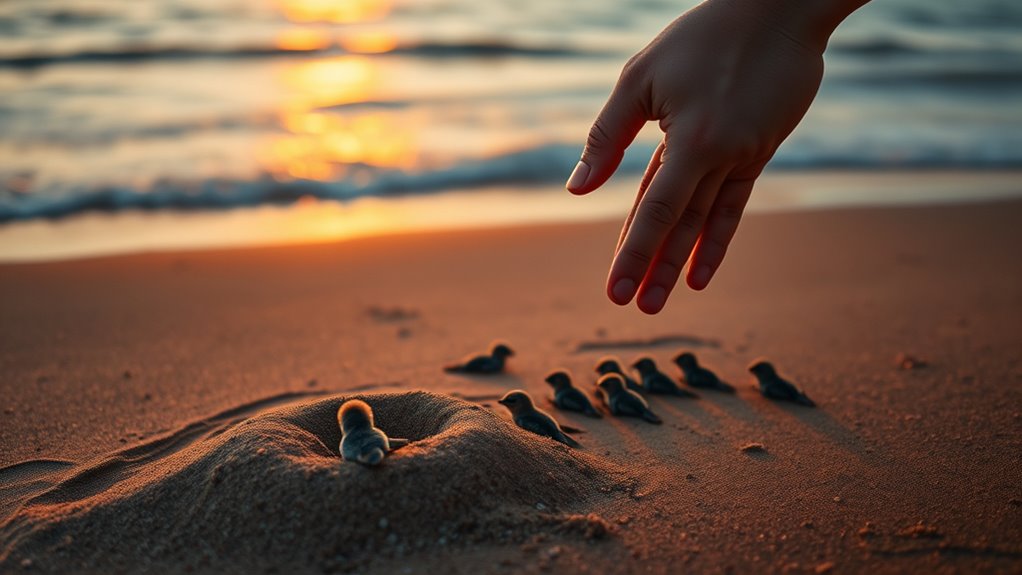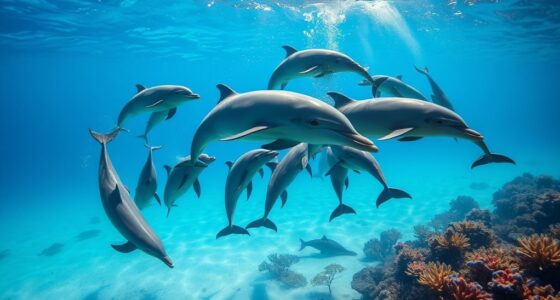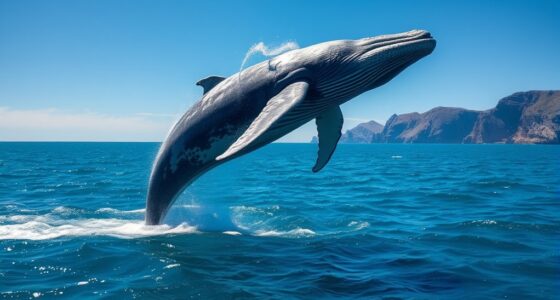To help sea turtles from nest to ocean, support Marine Protected Areas that safeguard nesting beaches and feeding grounds. Reduce fishing bycatch using turtle excluder devices, and participate in community cleanups to minimize pollution. Promoting sustainable fishing practices, advocating for strong policies, and choosing eco-friendly products all make a difference. By taking these steps, you contribute to their survival—discover more ways you can make an impact as you continue your journey to understand their world.
Key Takeaways
- Protect nesting beaches through habitat preservation and community-based conservation programs.
- Reduce bycatch with turtle excluder devices and sustainable fishing practices.
- Raise awareness via education, beach cleanups, and eco-friendly choices to prevent pollution and debris.
- Establish and enforce Marine Protected Areas to safeguard critical habitats and migratory routes.
- Support policies and research that promote turtle-friendly gear, habitat restoration, and long-term population monitoring.

Sea turtles face numerous threats that endanger their survival, but your actions can make a difference. One of the most effective ways to protect these majestic creatures is through the establishment of marine protected areas (MPAs). These designated zones help conserve critical habitats such as nesting beaches, feeding grounds, and migratory corridors. When you support or advocate for MPAs, you’re helping ensure that turtles have safe places to rest, feed, and reproduce without the constant threat of human disturbance or habitat destruction. MPAs also reduce the risks posed by pollution and illegal activities, creating a sanctuary where sea turtles can thrive. By promoting the creation and enforcement of these protected zones, you contribute directly to their long-term survival. Establishing MPAs can also serve as a model for creating sustainable marine environments, ensuring the health of oceans and their inhabitants for future generations.
Another significant threat to sea turtles is bycatch, which occurs when they are unintentionally caught in fishing gear like nets, trawls, and hooks. This can lead to injury or death, severely impacting local populations. Fortunately, bycatch mitigation measures are making a difference. Techniques such as turtle excluder devices (TEDs) are installed in fishing gear to allow turtles to escape safely. When you support sustainable fishing practices and choose seafood that adheres to bycatch reduction standards, you help reduce this deadly threat. Additionally, working with fishermen and communities to adopt turtle-friendly gear and practices creates a safer environment for these animals. Your awareness and advocacy can push for stricter regulations and innovative solutions that minimize accidental catches, giving turtles a better chance to reach adulthood and reproduce. Implementing bycatch reduction strategies is crucial for the continued recovery of sea turtle populations. Promoting research and innovation can lead to new methods that further protect these creatures.
Supporting marine conservation programs not only benefits sea turtles but also helps preserve the overall health of marine ecosystems, which are vital for countless species, including humans. Every step you take in supporting marine conservation efforts directly impacts the future of sea turtles. Educating others about the importance of protecting nesting beaches and migratory routes fosters a community committed to their preservation. Participating in local beach cleanups reduces pollution that could harm hatchlings or block their pathways to the sea. Choosing eco-friendly products and reducing plastic use decreases the amount of debris that often ends up in oceans, where it can be ingested or entangle turtles. Your voice matters—by supporting policies and organizations dedicated to marine conservation, you help strengthen the efforts to establish more MPAs and enforce bycatch mitigation strategies. Supporting community-based conservation programs can also enhance local engagement and success. Additionally, understanding marine habitat preservation can help you make informed decisions that benefit sea turtle populations.
From protecting nesting sites to advocating for sustainable fishing, your involvement plays an essential role in ensuring sea turtles can complete their journey from nest to ocean. Every action, no matter how small, adds up to meaningful change. When you stay informed and actively participate in conservation initiatives, you help secure a future where these ancient mariners continue to grace our oceans. Together, through mindful choices and dedicated efforts, you can make a lasting difference in saving the sea turtles for generations to come.
Frequently Asked Questions
How Do Climate Change and Global Warming Affect Sea Turtle Nesting?
Climate change and global warming impact sea turtle nesting by causing climate-induced nesting shifts, which alter where turtles lay their eggs. Rising temperatures can skew gender ratios, as warmer sands produce more females. You might notice that these changes threaten turtle populations, making it vital to address global warming impacts. Protecting nesting sites and reducing carbon footprints can help support turtles’ natural nesting behaviors and guarantee their survival.
What Are the Main Predators of Hatchling Sea Turtles?
Imagine facing an army of predators at every turn—that’s what hatchling sea turtles encounter. Egg predation from crabs, raccoons, and birds dramatically reduces hatchling survival. Once they reach the ocean, predators like fish, crabs, and sharks target these tiny creatures. Your understanding of these threats highlights how vital it is to protect nesting sites and hatchlings, giving them a fighting chance to grow and thrive in their natural habitat.
How Can Local Communities Participate in Sea Turtle Conservation?
You can get involved in sea turtle conservation by supporting community-led patrols that monitor nesting sites and prevent poaching. Participating in eco-tourism initiatives allows you to promote awareness and generate funds for conservation efforts. Volunteer with local organizations or educate others about the importance of protecting these creatures. Your active involvement helps make certain that sea turtles thrive, from their nests to the vast ocean beyond.
What Are the Legal Protections for Endangered Sea Turtle Species?
Ever wondered how laws safeguard endangered sea turtles? Legal frameworks and conservation regulations play a crucial role in protecting these creatures. You’re supported by strict international treaties like the Endangered Species Act and CITES, which ban hunting and trade. These regulations also establish protected areas and restrict disturbing nests. By understanding and upholding these protections, you contribute to the ongoing effort to preserve and recover sea turtle populations worldwide.
How Do Pollution and Plastic Waste Impact Sea Turtle Health?
Pollution and plastic waste seriously harm sea turtle health by increasing marine debris, which they often mistake for food. You might see turtles ingest plastic, leading to injury or death, as it causes blockages or internal damage. Plastic ingestion also weakens their immune systems, making them more vulnerable to disease. Reducing marine debris and plastic waste helps protect sea turtles, ensuring they stay healthy and can continue their essential role in marine ecosystems.
Conclusion
By protecting sea turtles from threats like pollution and poaching, you can make a real difference. Some might say your efforts won’t change much, but every small action counts—whether it’s avoiding plastic or supporting conservation programs. If we all pitch in, we help guarantee these incredible creatures continue their journey from nest to ocean for generations to come. Don’t wait—your help is essential to saving these amazing animals before it’s too late.









